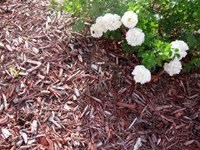Dakota Gardener: Dealing With Drought in the Backyard
(Click an image below to view a high-resolution image that can be downloaded)
By Tom Kalb, Horticulturist
NDSU Extension
Conditions are very dry in North Dakota. Most of the state is suffering from a severe drought.
We can irrigate plants in our backyard to relieve their stress, but this can get expensive. Here are some tips on how to make every drop of water count.
The first step is to prioritize your watering. Young trees and shrubs get the first drink. These plants suffered shock when they were transplanted and most likely have weakened root systems. These plants are vulnerable and valuable in landscapes.
Plants in gardens and flower beds get the next drink. Many of these plants are sensitive to dry conditions.
Lawns are tougher. They can go dormant. Only under the most severe and persistent droughts do grasses die out. Likewise, mature trees rarely need irrigation.
Mulching your plants to conserve the moisture in your soil is important. Exposed soil can lose twice as much moisture as mulched soil. Use wood mulches around trees, shrubs and flowers. Rock mulches are much less effective. Use straw/hay or plastic mulch in veggie gardens.
Now is the time when many of us go to garden centers to buy new plants for our landscapes. The drought we are facing today reminds us of the importance of selecting plants that can tolerate dry conditions.
This is termed “xeriscaping.” Xeric plants can grow with minimal watering once they are established. Examples include daylily, coneflower, blanket flower, sedum, salvia, liatris, Russian sage, catmint and yarrow.
Use water efficiently when you irrigate your plants. Irrigate in the morning. Plants in the morning will absorb the water actively before it evaporates away in the midday heat.
Avoid windy days and hot afternoons because you will lose much of this water to evaporation before it is absorbed by plant roots.
Avoid overhead sprinkling. Much of the water that comes out of an overhead sprinkler evaporates before it lands on the ground. Aim your water at the base of the plants near the roots. Hand watering, soaker hoses and drip irrigation work best.
Adjust your sprinklers to avoid irrigating sidewalks and driveways. If runoff is a problem (for example, on a sloped lawn), split your applications into two or more sessions.
The way you mow your lawn makes a big difference. Mow tall and let the grass clippings fall.
Tall grass plants resist drought by shading the soil. Tall turf naturally develops deeper roots. Tall turf stays green longer.
Don’t collect lawn clippings. The clippings will mulch the soil, keeping it cooler and reducing drought stress on the lawn.
Consider using a rain barrel. During a 1-inch rainfall, 0.6 gallon of water falls on each square foot of your roof. That’s more than 1,000 gallons for an average roof (1,700 square feet).
That’s a lot of water we can use to irrigate our flowers, trees and shrubs. Collected rainwater is especially beneficial for plants in North Dakota because it is slightly acidic and will release nutrients in soil to plants.
This is not our first drought, and it won’t be our last. Even in a normal year, North Dakota is a relatively dry state. For now, and in the future, let’s make every drop of water count.
For more information about gardening, contact your local NDSU Extension agent. Find the Extension office for your county at https://www.ag.ndsu.edu/extension/directory/counties.
NDSU Agriculture Communication - April 13, 2021
:Source: Tom Kalb, 701-328-9722, tom.kalb@ndsu.edu
:Editor: Ellen Crawford, 701-231-5391, ellen.crawford@ndsu.edu




